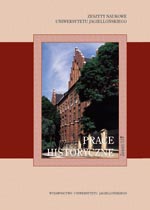Instytucja zebrania ogólnego profesorów w państwowych szkołach akademickich II Rzeczypospolitej
Institution of the Professors’ General Meeting at the Public Universities in the Second Polish Republic
Author(s): Jarosław JastrzębskiSubject(s): History
Published by: Wydawnictwo Uniwersytetu Jagiellońskiego
Keywords: Polish history; general history; ancient history; medieval history; modern history; contemporary history; political history; military; economic and social history
Summary/Abstract: The article describes the institution of the Professors’ General Meeting which constituted the highest collegial self-government body at universities in the Second Polish Republic. The basic formal and legal conditions for the functioning of the institution are described. The body of the article is divided into six parts. The introduction points to the unique nature of the General Meeting in the context of Polish academic legislation of the 20thcentury and the fi rst decade of the 21st century as well as the grounds for commencing the research from the date of 15 September 1920. Subsequently, the system of public academic education is described, including the classifi cation of universities within the scope relevant for the subject of the research, and academic privileges considered unique in comparison with other research and education units are specifi ed. The second chapter discusses the institution of the Professors’ General Meeting and its three stages of development that can be identifi ed in the interwar period. The author also analyzes the member roster and its changes in time as well as the impact that the academic groups (teachers, administrative employees and students, including all ranks and categories) exercised upon the functioning of the university, comparing the 1920–1939 period and the Third Polish Republic. The next chapter describes the basic procedures of the Professors’ General Meeting. The further deliberations concern the detailed competences of the body with special emphasis put on the reduction of these competences and their classifi cation in terms of dependence on or independence from the approval of the Minister of Religious Denominations and Public Education. Additionally, the specific character of the Professors’ General Meeting in one-faculty universities in 1933–1937 is also discussed since the rights of that body in such cases were extended by the responsibilities of the faculty council and the university senate. The article is concluded with a summary of basic facts from the history of the institution of the Professors’ General Meeting at public universities in the interwar Poland and an attempt to explain the conspicuous tendencies in its development and the reasons for this development.
Journal: Prace Historyczne
- Issue Year: 137/2010
- Issue No: 1
- Page Range: 123-135
- Page Count: 13
- Language: Polish

